Judy Middleton (2003 revised 2015)
 |
copyright © J.Middleton
The exterior of St Andrew’s Church, Portslade, was photographed in 2009. |
A Victorian Church
Revd F.G. Holbrooke was Vicar of Portslade from 1859 to 1880 and it was during his time that it was decided to build St Andrew’s Church to serve an area of growing population in the southern part of the large parish. In those days it was known as Copperas Gap (later on it became Portslade-by-Sea) and the new church would also serve the people of Fishersgate. The two areas had a population of around 550 people in each and there was to be enough seats for 300 people at St Andrew’s.
The Hall family owned land at Portslade and lived there too but when Revd William Hall donated the site for the new church, he was Rector of Saxham Parva, Bury St Edmunds. Although the donation only concerned enough land for a church building, it was hoped that extra land for a churchyard might be forthcoming at a later date. But Revd Hall refused to countenance the idea. By this time the situation was becoming serious because the small churchyard around the ancient church of St Nicolas was full up; this is the reason why in 1871 Portslade authorities sought to establish a new burial ground elsewhere.
This was not the only difficulty surrounding the birth of the new church. Apparently, the Rector of Southwick felt aggrieved because his views on the matter had not been taken sufficiently into account. He seemed to regard Copperas Gap as being within his sphere of responsibility and he may well have been right. He felt that parish boundaries should have been sorted out well before the church was consecrated. Instead it was the other way around and the Rector felt there had been some sort of behind-the-scenes agreement between the Bishop of Chichester and Revd Holbrooke. It is a fact that the choice of a clergyman for the new church became the responsibility of the Vicar of Portslade.
It is possible this row had something to do with the Hall family who donated the site for St Andrew’s in the first place. Perhaps they also expected to exert patronage over the new parish. The Hall family had considerable land holdings in Portslade dating back to 1795 when Nathaniel Hall purchased Portslade House Estate consisting of 272 acres. The Hall family also owned land in Southwick including the site where the Roman villa was once located. There was a family vault at the Church of St Michael and All Angels, Southwick. Possible the fall-out over patronage and boundaries led to the refusal to make land available for a churchyard.
A Famous Architect
Edmund Evan Scott practised as an architect in London before moving to Brighton in 1853 and by the 1860s he was working from premises in Russell Square; by 1871 he was established at 46a Regency Square. His first partner was a Mr Suter and the two of them designed St Andrew’s Church, Portslade. On his own account Scott designed the Brackenbury Schools, Locks Hill in 1872 and the chapels in Portslade Cemetery at around the same time. It is likely he designed the Brackenbury Chapel at St Nicolas too. Later on he became associated with nearly all of Wagner’s church-building and church-enhancing schemes at Brighton, including the Church of the Annunciation, St James’s Church, All Souls’ Church and with his later partner designed St Saviour’s Church. But by far his most important work was St Bartholomew’s, Brighton, a building of such size and magnificence it is impossible to ignore.
It is interesting to note that while Scott’s Portslade buildings made great use of local flints, St Bartholomew’s was an essay in red brick. St Andrew’s, Portslade was designed in the early English style with a fleche. The total cost came to £1,541 and included the surrounding walls and gates; Cheesman & Co built the church. The money came from public donations, grants from the Diocese of Chichester, and also from the Incorporated Church Building Society. The church was opened in 1864.
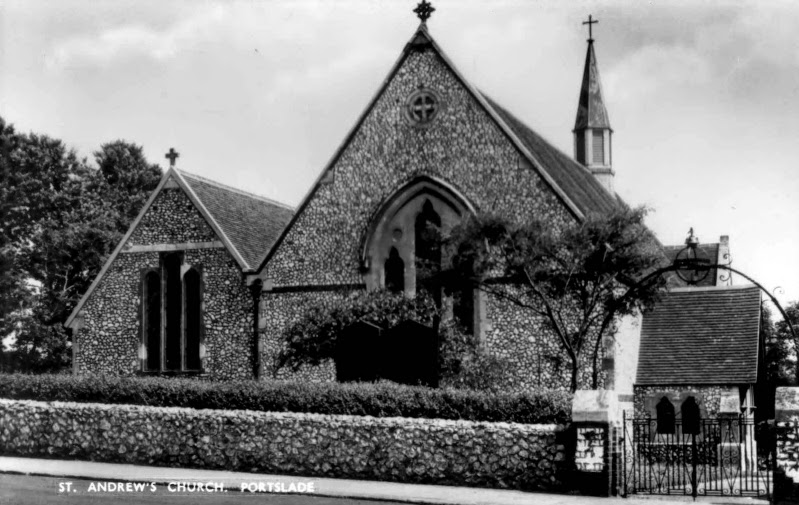 |
copyright © J.Middleton
St Andrew’s Church was opened in 1864; this postcard view dates from the 1950s. |
Revd Richard William Enraght (1837-1898)
In 1871 Revd Richard William Enraght arrived in Portslade with his wife Dorothea and their children. The Enraghts had seven children altogether and their fifth child, a daughter called Grace, was born while they lived at Portslade. They lived at Courtney Terrace in a house now numbered as 5 Station Road.
copyright © D.Sharp
Revd Enraght lived in this house now numbered as 5 Station Road but in his day it was Courtney Terrace.
Revd Enraght was appointed curate-in-charge of the newly created parish of St Andrew, Portslade and St Helen, Hangleton. It is interesting to note that Revd Holbrooke, as vicar of Portslade, had the power to appoint a priest to this parish of his own choosing. This meant that he must have been entirely aware of Enraght’s strong leaning towards Anglo-Catholic practices at a time when the Established Church was still predominately Protestant. After all, before moving to Portslade, Revd Enraght had served as curate at St Paul’s, West Street, Brighton, which was famous for its high church ceremonies.
It seems evident that Revd Holbrooke held progressive views. For example, when St Andrew’s was opened it was unusual in not charging pew-rents, which had been the norm in the Church of England. Revd Enraght thoroughly agreed with their abolition because he felt it was unfair to poorer folk. This meant that St Andrew’s was open to all and nobody could ‘buy’ a pew.
It would be interesting to know whether or not Revd Enraght introduced any Catholic practices at Portslade. Whatever he did, he must be credited with building up the congregation in a church that had only existed for seven years previous to his arrival.
In 1872 while he was living in Portslade, Enraght published a powerful pamphlet entitled The Real Presence and Holy Scripture. It may be that Gosset read it and that this was the cause of his anger.
Frederick Richard Mealy Gosset was a retired officer of the Bengal Army and lived in a stately Georgian house called simply Portslade House at the western end of High Street. The 1871 census recorded him living there with his wife Mary and children Maud 18, Allan 12, Marion 10, Evelyn 9, Ethel 7, Zoe 5 plus eight servants. Gosset was obviously of a strict Protestant persuasion because he was outraged by Enraght and stated the clergyman adhered to the Church of Rome in all but name. Enraght could not let such a comment pass by and wrote a letter to Brighton Gazette protesting at such a slander.
 |
copyright © J.Middleton
This is Portslade House where Gosset lived with his family and servants; it later became Windlesham House School. |
It seems that whatever had happened at St Andrew’s in the 1870s, by 1890 it was following a Protestant path. At any rate a newspaper report of that year recorded a Communion Table and a reading desk, items associated with Protestant practices.
The Enraghts left Portslade in 1874. But Father Enraght continued resolutely on his path towards Anglo-Catholic worship and being unpopular with the Establishment did not deter him. Indeed, he was so convinced of the rightness of his beliefs that he was prepared to spend 49 days in Warwick Jail after he was convicted of breaking the law; even the man in charge of the jail thought it was quite wrong that the clergyman should have been sent to prison. Thus Revd Enraght became famous throughout the world as a Prisoner of Conscience.
A Crowded Church
The Bishop of Chichester dedicated the St Andrew’s Church on 18 October 1864. It became so popular that soon 300 sittings were not enough for all the people wanting to attend. Plans were prepared for the building of a north aisle, which would provide 150 extra seats.
The Bishop of Chichester laid the foundation stone on 21 June 1890. The Bishop was attended by Revd Canon Borrer, who acted as his chaplain. Mrs Richard Smith, Miss Sharp and the Misses Powell were responsible for the floral decorations and there were some splendid vases of white flowers on the Communion Table. ‘The pulpit was trailed with ivy, relieved with blossoms, a handsome basket of flowers hung in front of the reading desk and there was a profusion of flowers in front of the choir stalls.’
The well-known London architect Reginald T. Blomfield prepared the plans and Mr Peters of Horsham was the contractor. The new north aisle cost £911 and already by the time of the stone-laying ceremony some £600 had been collected. The money came from donations by the congregation and from the proceeds of bazaars, concerts and outside appeals. The building committee contained a host of well-known Portslade men such as W. Dudney, Frederick Sundius Smith, J. Blaker, J. Miles and W. Hillman. It was hoped the existing vestry would eventually be removed, and a new vicar’s vestry and choir vestry built with the organ chamber over them.
A Pretty Wedding
On 7 June 1898 ‘Portslade was enlivened by a very pretty spectacle, the simultaneous wedding at St Andrew’s of two sisters, the Misses Annie and Alberta Bennett, eldest and youngest daughters of Mr Albert Bennett of The Gables.’ Frederick George Holland and George Hard were the bridegrooms and they had been connected with the choir of St Andrew’s for some time.
‘The brides were tastefully dressed in white alpaca, trimmed with white lace and satin and with wreaths of orange blossoms.’ They carried bouquets of roses, marguerites and ferns. The bridesmaids Maggie Holland and Maisie Hard ‘were dressed in pale grey poplin trimmed with blue shot silk’. As the couples left the church guests threw rice over them. Revd C.A.Marona married the couples and afterwards attended the wedding breakfast.
A Sad Funeral
Tom Peters was born in 1866 in Alma Cottage in Portslade Old Village. By 1906 he was landlord of Sussex Arms, Fishersgate, and had two pretty daughters named Florence aged 22 and 17-year old May. On Saturday 3 February 1906 they went on a sailing boat trip with two young men named Emery and Scholfield. They were returning home and were within a stone’s throw of their father’s house when a sudden gust of wind caught the sail and the boat capsized.
Scolfield saved his own skin by swimming for the shore. But Emery was made of sterner stuff and tried his best to save the struggling sisters. He held both of them up for some time but just as the rescue boat was nearing them, the girls released their hold on Emery and sank; no doubt their struggles and the bitter cold exhausted them. The rescue party managed to locate May and artificial respiration was applied for two hours but with no success. Florrie’s body was not found until the following day.
On the day of the funeral the local newspaper recorded that ‘Little knots of sympathisers reverently raised their hats as the cortege passed through the streets, and St Andrew’s was crowded to overflowing. Women sobbed quietly through the service, and in drenching rain a great number of people marched behind the mourners’ coaches to Portslade Cemetery. Conspicuous in the procession was a cart laden with beautiful wreaths.’
One sister remained and she married a Mr Davis who taught at Portslade Industrial School. He was a big, red-faced man who was fond of propping up the bar at the Stag’s Head.
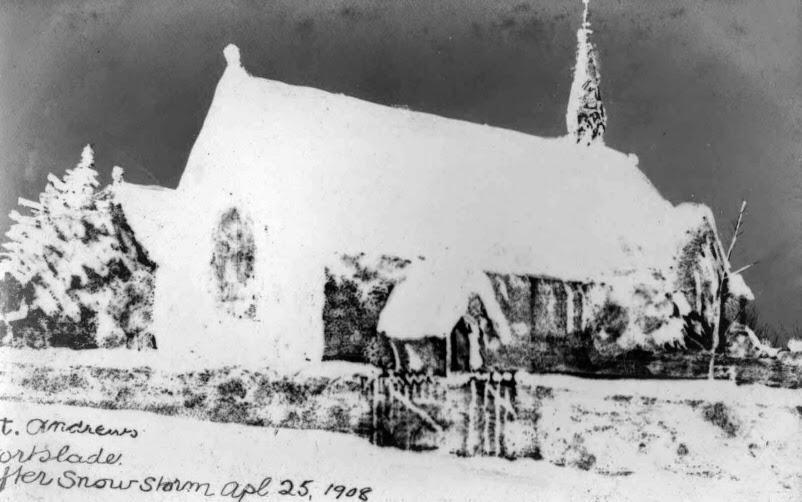 |
copyright © J.Middleton
This photograph looks like a negative; in fact it shows St Andrew’s Church almost blotted out by the snowstorm of 25 April 1908. |
Church Parade
In May 1913 St Andrew’s was host to a church parade attended by the 6th (Cyclist) Battalion, Royal Sussex Regiment, and members of the Territorial Army.
Bishop Walter Baddeley (1894-1960)
Walter Baddeley was born in Portslade where his father ran a grocery shop in North Street, the main shopping area of Portslade in those days. His relatives called him Hubert (his second name) to avoid confusion with his father who was also called Walter. But in his later professional life he was always known as Walter. He had a younger brother and two sisters.
Walter Baddeley had fond memories of his childhood at Portslade and especially the times he and his friends used to go down to the beach after school to watch the fishermen at work. The fishermen waited all ready on the shore until a shoal of mackerel was spotted and then they quickly embarked and let down their nets to enclose the fish. When the fishermen returned to shore, the boys helped them with the nets and were often given two or three mackerel for their tea.
The Baddeleys attended services at St Andrew’s and Walter became a Sunday School teacher. There cannot be many parishes that can claim to have nurtured the spiritual life of a future bishop.
In 1912 Walter Baddeley started on his studies at Keble College, Oxford with the help of a scholarship he was awarded. But when the Great War broke out, he had no hesitation in interrupting his academic life to do his bit for his country. He and his brother Alfred James Baddeley both served with the Royal Sussex Regiment. But the outcome was so different for the brothers. Lieutenant A.J. Baddeley was only nineteen years old when he was killed in action in 1918. Meanwhile, Walter seemed to lead a charmed life because although he was on active service from July 1915 to 1918, he came through unscathed and he was a military hero as well. He was Mentioned in Despatches no less than four times, awarded the Military Cross twice and in 1919 received the Distinguished Service Order and Bar.
copyright © D.Sharp
The people of Melanesia made this cross with inlaid abalone shells for their Bishop,
Right Revd Walter Baddeley.
Then he returned to his studies at Oxford and he was ordained a priest in 1921. In 1932 he was consecrated as the 7th Bishop of Melanesia at St Mary’s Church, Parnell, New Zealand on 30 November, the feast day of St Andrew to remind him of his links with his old church in Portslade. He looked after a vast diocese of islands scattered over the Pacific Ocean.
But the storm clouds of the Second World War were gathering and when the Japanese threat of invasion seemed imminent, he ensured his wife and children were taken to safety in Adelaide. But the Bishop famously said ‘I’m staying’ and disappeared into the bush, bringing comfort to the people he served as best he could. He was in the Solomon Islands when the Japanese invaded on 26 January 1942. The Bishop was also on hand when the Americans arrived and he became honorary chaplain to USA troops as well as those from New Zealand. The Americans recognized the sterling work he carried out under Japanese occupation and awarded him the United States Medal of Freedom with Palm. In 1944 the Bishop was created an honorary Doctor of Sacred Theology of Columbia University, New York for his work amongst the troops and for helping to maintain morale.
In the early 1960s the north aisle of St Andrew’s Church, Portslade, was altered to become a memorial to Bishop Walter Baddeley. L. Keir Hett prepared the plans and the Faculty was dated 21 August 1962. The church was presented with a beautiful cross the people of Melanesia created from abalone shells for their Bishop.
War Memorial
Norman & Burt of Burgess Hill made the war memorial in 1921. It is quite an unusual memorial because instead of the customary brass or stone, it takes the form of wooden triptych painted red and blue. The Faculty for the memorial was dated 7 February 1921 and it is worth noting that the words For England, Home and Duty now proudly displayed on the triptych do not appear anywhere on the Faculty. It seems someone, overcome with patriotism, added them later and presumably the authorities did not pick up on the extra lettering.
 |
copyright © D.Sharp
The beautiful and unusual war memorial at St Andrew’s Church. |
Thankfully, the war memorial is still with us although it has been subject to several removals. Its original position was probably near the altar but was later fixed to the west wall. When the church was stripped of furnishings, prior to rebuilding work, the war memorial was removed and stored over the road at Baker’s, funeral directors, for safekeeping. In 2005 it was time to rescue the memorial and the volunteers found it had been placed in the coffin storeroom. The memorial was placed on the wall of the newly created Baddeley Room upstairs in the Community Centre. Unfortunately, people using this space were unhappy about its presence and the war memorial has since been relegated to the wall of the stairwell. It is hoped that at some stage it will be restored to the walls of the Church.
Second World War
St Andrew’s Church did not receive a direct hit during the war but it did receive collateral damage on two occasions. The first occurred in August 1942 when bombs fell on St Richard’s Road; the second time was in January 1943 when a landmine exploded on Gas Works Beach.
Prisoners of War in the Far East created a cross, inlaid with tiny snail shells and it was used in services. The cross was presented to St Andrew’s.
Recent Times
In 1954 the roof of the church was re-conditioned. White & Son of Trafalgar Road, Portslade rebuilt the bell turret.
The year 1962 was an interesting one in the matter of church affairs because until then the vicar of St Nicolas, as vicar of Portslade, held the power to nominate the priest to serve at St Andrew’s. On 20 July 1962 this power was conveyed to the Church Commissioners.
In 1983 tenor William Carpenter notched up 70 years of service in the choir of St Andrew’s, where he had also been baptised. During this time he had worked under thirteen different priests.
Parish boundaries were shifted around in the 1980s when the arrangement where one priest looked after St Andrew as well as St Peter’s Church, Fishersgate came to an end. Instead, the parishes of St Nicolas and St Andrew were combined with one priest in charge.
There was a change in the physical landscape too because St Andrew’s Vicarage was demolished. It had been built on glebe land belonging to the church and it was a handsome red-brick structure erected in around 1880. In 1911, when additions and alterations were carried out to the vicarage, the parish was obliged to take out a mortgage of £200. This debt was not paid off until April 1931 and it is amusing to note that an unknown hand (perhaps the vicar or treasurer) wrote Laus Deo on the envelope containing the document as though weary of having this burden. The vicarage was surplus to requirements and Portslade Health Centre was built on the site; it opened in 1982.
Vandalism
The vicarage was gone, the congregation was dwindling, and the priest lived in the village. Thus St Andrew’s Church became an easy target for vandals.
In July 1995 petrol was poured under the vestry door and set alight. The main roof and vestry were damaged in the blaze. Unhappily, this attack was just the latest in a whole list of mindless acts.
In October 1995 there was another blaze at the church on a Saturday night. Firemen managed to put out the main fire within a couple of hours but they had to remain on site throughout the night to damp down smouldering timbers. Revd Richard Rushforth stated the blaze had weakened around one-fifth of the main roof while the vestry roof had completely gone.
Over a period of eighteen months, vandals used battering rams to smash down the north door, they broke windows, scattered books about the church and stole ornaments.
In July 1997 Father Rushforth said that during the previous three years damage to doors and windows amounted to some £50,000 whereas the amount agreed to by the insurance company following the arson attack was £48,671.
In January 2003 the church was again broken into, wine was stolen and there was an attempt to remove the safe.
Alternative Uses
The problems seemed un-surmountable and then help came from an unexpected quarter.
In March 1999 it was announced that South Coast Power would donate £350,000 towards a community centre in south Portslade by way of compensation for the disruption caused by laying a new gas main. People were delighted at the prospect and expected something dramatic to happen more or less overnight. Four years later it seemed that nothing had moved on. But behind the scenes plans were progressing, although somewhat slowly. The idea was to create communal spaces within the church while retaining the chancel area as a small chapel. But first of all there were legal technicalities to be sorted out, the lease to be debated, plus the due process for declaring part of the church redundant and extra funding to be sought.
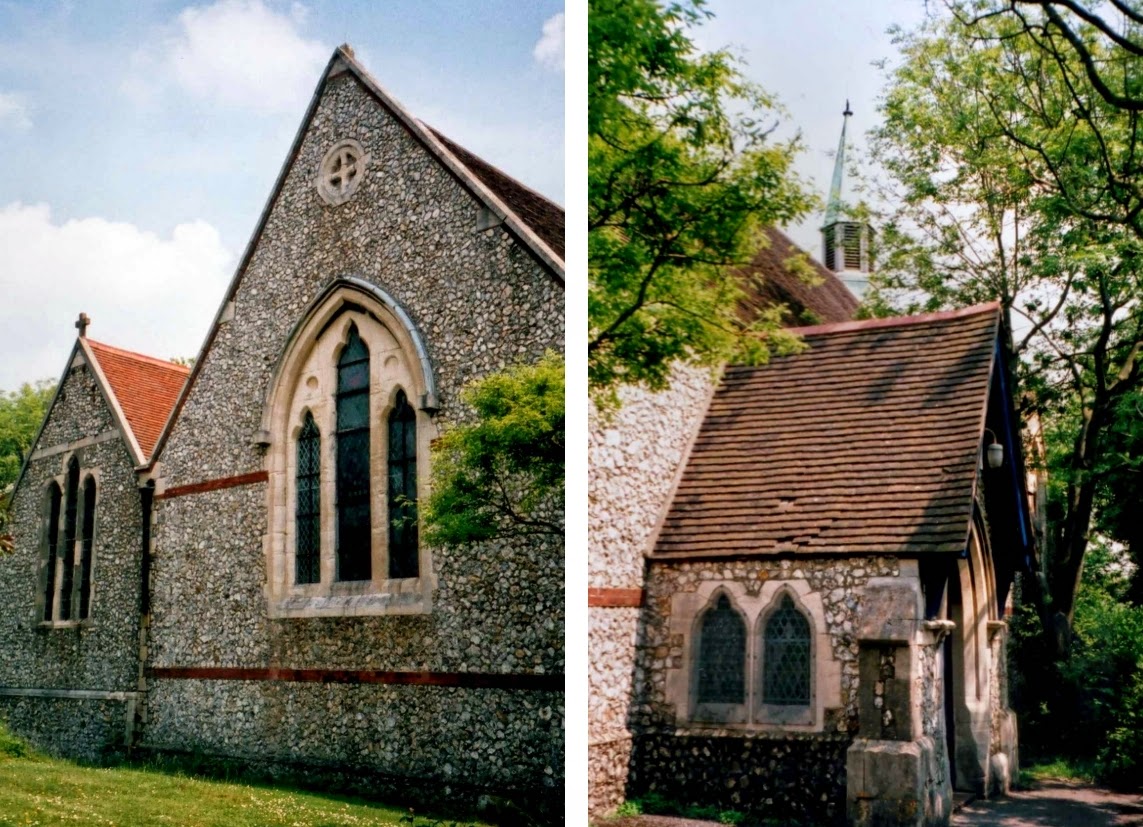 |
copyright © J.Middleton
These two photographs were taken in 2003 before major reconstruction began to turn the building into a community centre and smaller church. |
Meanwhile, Clive Mercer, Diocesan architect, produced two sets of plans for the conversion in order that people could debate the issue and express a preference. The creation of the smaller church, or worship area, was expected to cost in excess of £220,000 funded by the parish.
In late March 2003 there came the welcome news that CAPS (Community Association Portslade [South]) had secured a grant from the National Lottery of £295,000. This money, together with £350,000 from South Coast Power, would be sufficient to start building the community centre inside the church to consist of a hall and kitchen on ground level and another hall and meeting rooms on a suspended floor above.
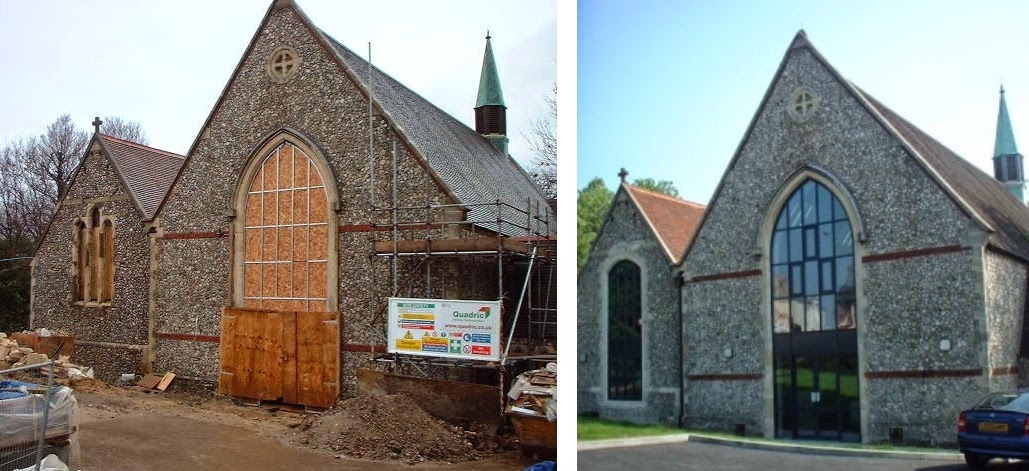 |
copyright © D.Sharp
In December 2003 work was well underway in the coversion of St Andrews into a community centre and smaller church Left photo shows the re-ordered building completed in July 2004. |
A Tour of St Andrew’s Church in 2003
Sanctuary
 |
copyright © D.Sharp
1) Photo left:- The Nativity window that formerly adorned the sanctuary.
2) Centre photo:- This fine window depicting the crucifixion was once the central light in the sanctuary.
3) Photo right:- The beautiful resurrection window was given in honour of Edward VII’s coronation. |
1. The window on the left depicts the Nativity. There is a star at the top, an angel over Bethlehem in the distance while Joseph wearing a dark red garment with a green mantle carries a lantern. Mary wears her traditional blue robe but surprisingly she has a red halo and a white mantle resembling a priest’s vestments. The window was donated in 1904 to the memory of Charles Richard Smith, owner of Britannia Flour Mills, and his wife.
2. The crucifixion occupies the central light with the figure of Jesus set against a dark background with an obscured sun of a red hue on the left and the moon on the right. His halo is red interspersed with yellow. The window dates from 1896.
3. The right-hand light depicts the resurrection with a dove at the top. Again Jesus has a red halo. This window was installed in 1902 to commemorate the coronation of Edward VII.
Chancel
copyright © J.Middleton
This characteristic design by Sir Edward Burne-Jones
shows St George on the left and St Wilfrid on the right.
4. Above the two-light window there is a small central light with an angel adorned with red and pink wings and holding a musical instrument.
5. On the left there is the armour-clad figure of St George sporting a purple, knotted scarf around his throat and a red cloak. The window was given in memory of Ronald Christian Sundius Smith 2nd Lieutenant Indian Army, attached to the 2nd West Yorkshire regiment, who was killed in action at Neuve Chappelle on 12 March 1915.
6. On the right there is the figure of St Wilfrid wearing his bishop’s vestments and there are lovely hues of deep blues and green in the background of both windows. This window was given in memory of Revd C.A. Marona, vicar of St Andrew’s 1889-1915.
The windows were created from designs by the famous artist Sir Edward Burne-Jones (1833-1898). There exists a bill for the St Wilfrid window dated 1915 for £38-3s from the firm of Morris& Co.
South Wall
 |
copyright © J.Middleton
This window was given in memory of Lieutenant French who was lost in the Great War aboard HMS Good Hope.
When the Germans sank HMS Good Hope and HMS Monmouth at the Battle of Coronel on 1st November 1914, 1,600 men drowned. |
7. The window depicts Jesus walking across the waves to St Peter whose sudden doubts left him floundering. At the foot of the window, in the left-hand corner, there is a Union flag, an anchor and a laurel wreath. The window was given in memory of Lieutenant Edward John French of HMS Good Hope ‘who died in the service of his country in action with a German squadron off the coast of Chili (sic) in which both HMS Good Hope and HMS Monmouth were lost with all hands on board All Saints Day 1914.'
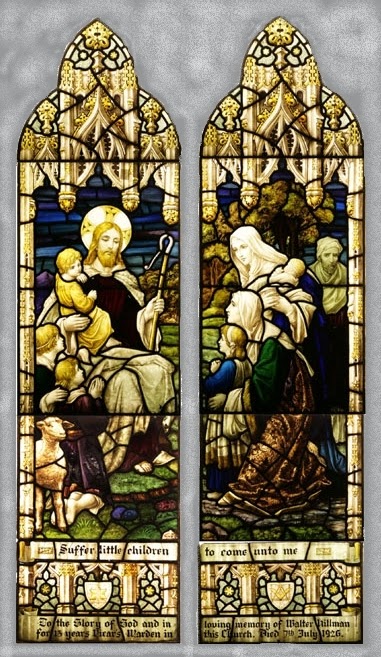 |
copyright © D.Sharp
The ‘Suffer Little Children to come unto Me’ window was in
memory of Walter Hillman.
Note the Masonic compass symbol at the foot of the right-hand light |
8. The next window illustrates the time when Jesus said ‘Suffer the Little Children to come unto Me.’ Mothers wear beautiful fabrics while a pale and disgruntled disciple lurks in the background. It is interesting to note the window incorporates Masonic symbols such as compass and plumb-line. Such a thing would never be allowed today but in the 1930s the church and Freemasonry were quite at ease with one another. Indeed the foundation stone for an extension to St Leonard’s Church, Aldrington, was laid with full Masonic honours in 1936. The window was in memory of Walter Hillman, merchant and contractor, who served as vicar’s warden for thirteen years. Hillman was a leading light in local Freemasonry circles and the first initiate of the Duke of Richmond Lodge, Portslade. Some of the congregation found the central theme of the window somewhat ironic because Hillman was a terrifying character to many local children.
West Window
 |
copyright © J.Middleton
The West window contained three roundels. |
9. It seems that originally the three roundels were set in the central window of the sanctuary and were thus the earliest pieces of stained glass at St Andrew’s. They were moved when new stained-glass windows were installed in the sanctuary.
There exists a letter from Morris& Co dated 29 September 1919 stating ‘the simplest and least costly way of utilizing the side window for the west … I propose to keep the three circles as they are and place them in the centre light of the west window.’
There is also a bill dated 3 April 1916 from A.W. Loomes, bronze medallist and stained-glass artist, of 7 Blatchington Road, Hove for £13-10s, being the cost of altering three leaded light windows to fit the opening of the west window.
The top roundel is of a pelican, a symbol of Christian piety, the middle one features St Andrew, while there is a Paschal Lamb in the bottom one. The windows on either side of the central light are decorated with vine leaves and yellow ears of wheat.
Unfortunately, this window was the most vulnerable one in the church. During the Second World War, it sustained damage. In January 1988 vandals used stones and a milk bottle to punch twelve holes in the glass. The figures of St Andrew and the Paschal Lamb were targeted and the estimated cost of restoration was put at £1,000. In July 2002 stone-throwers again attacked the window. Nineteen painted-glass diamond-shaped panes together with one clear glass pane were broken. The cost of repair was put at £2,475.
North Wall
 |
copyright © J.Middleton
John Blaker donated this three-light window, the central light dating from 1891. |
10,11,12. John Blaker donated these three windows, the central one in 1891 and the two side ones in 1902. In the left-hand window, St Andrew brings forward the boy with five loaves and two fishes, the central light depicts St Andrew and St Peter while the right-hand light has St Andrew and St Philip. Heaton, Butler & Bayne of London were the firm that created the windows.
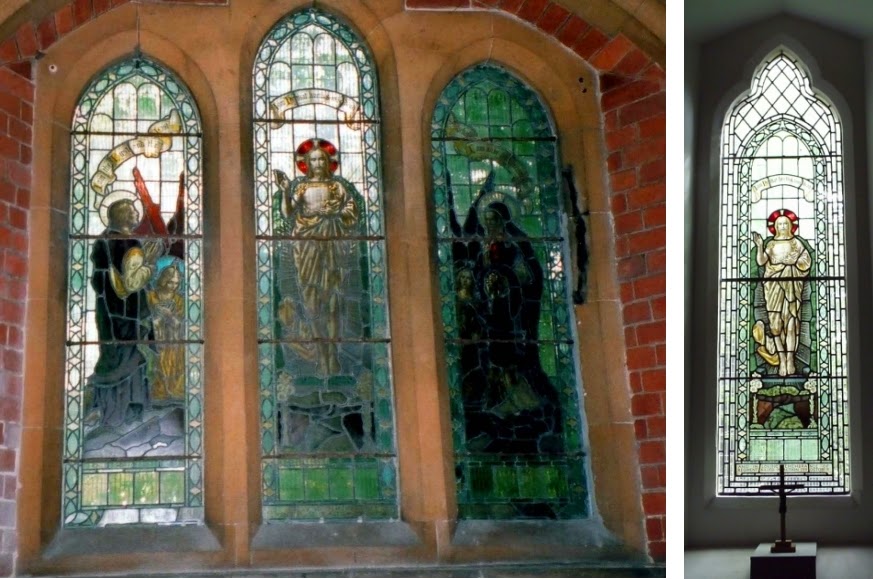 |
copyright © J.Middleton
Photo right:- As can be seen from the photograph outside foliage made this window rather dark. It was given in memory of Lieutenant Alfred James Baddeley killed in action in 1918. Today this window is to be found in the sanctuary, placed as three separate windows. Photo right:- This photograph shows the central light in its new setting. |
13,14,15. The three-light window highlighting the resurrection was given in memory of Lieutenant Alfred James Baddeley, Royal Sussex Regiment, who was killed in action on 23 October 1918 near Catillon, France. Ward & Hughes of 67 Frith Street, Soho, London, designed the windows and the Faculty was dated 21 June 1928.
Sanctuary
 |
copyright © J.Middleton
These tiles once adorned the sanctuary. |
The floor of the sanctuary is covered with original Victorian tiles in shades of dull red, ochre and green. The close-boarded roof is painted dark blue and adorned with gold stars. The story goes that years ago Sunday School children brought 3d each to pay for one star.
Pendant Crucifix
 |
copyright © D.Sharp
Pendant Crucifix can be seen hanging above the original sanctuary |
Revd Leycester-Ward, vicar of St Andrew’s 1915-1929, donated this cross in memory of his wife. The figure of Christ measures 5 feet 6 inches and wears a crown of real thorns. The Faculty for the pendent cross was dated 5 July 1927. The pendent cross was re-hung in June 2004 high on the west wall of St Andrews.
Pulpit
copyright © D.Sharp
The 'Booth' pulpit.
The original pulpit was a simple, wooden structure but later on it was replaced with a stone edifice fitted with five unusual painted metal panels. The figures represented in the panels are St Luke, St Andrew, the Good Shepherd, St Peter and St Paul. There seems to be no record of artist or date but around the foot of the pulpit there is an inscription to the memory of Edward Thomas Booth who died on 8 February 1890. This too presents us with something of a mystery because Booth was the man who created the Booth Museum in Dyke Road, Brighton. Whatever, you might think about the Victorian morality of shooting birds, including rarities, in order to stuff them and mount them in glass cases with an appropriate setting, today the collection is regarded as a valuable one. But Booth and his family had no known connection with Portslade and he was buried at St. Leonard’s-on-sea.
The Argus reported on the 21 October 2014, "The inscribed stone was given to the Booth Museum when the church was decommissioned."
Conclusion
It is obvious from the windows and furnishings that there were once wealthy patrons of St Andrew’s who could afford to donate costly items. It is ironic that the ancient church of St Nicolas, apart from the Brackenbury Chapel, remained resolutely unadorned. Indeed, some of the plain glass is ancient enough to be valuable in its own right.
It is sad to record that so many of the treasures recorded above were lost to Portslade when the building was converted into a community centre and only a small part remained as a chapel. Thankfully, the Burne-Jones windows were left in place. But the windows in the sanctuary, which were fine examples of their kind, were removed and replaced by the Baddeley three-light window from the north wall and installed as three separate windows. It seems that the chief merit of the windows chosen was that they let in more daylight but the Burne-Jones windows do not allow much light to penetrate but are glorious when the morning sunlight shines through them. Thus St Andrew’s lost many beautiful examples of stained-glass. It is not as though Portslade was rich in such pieces in the first place because there are only two small examples, both from the 20th century, at St Nicolas.
It may be of interest to record that the redundant stained-glass found a safe home in the London Stained Glass Repository. This is a charity run by the Worshipful Company of Glaziers and the glass is catalogued and stored for further use in this country or worldwide.
The pulpit was sold off but the pendent crucifix remained.
The newly re-ordered St Andrew's Church was officially reopened by the Bishop of Chichester in July 2004.
In September 2013 the status of St Andrew’s Church was changed and it became a Chapel of Ease. This meant there was no longer a requirement for a service to be held on Sundays and in future only an occasional service would be held there.
 |
copyright © D.Sharp
The re-ordered St Andrew's Church in 2013,
with the 'Baddeley' sanctuary stained glass widows |
Vicars
St Andrew’s did not have its own vicar until 1876.
1876-1889 Revd Edward Winterbottom
1889-1902 Revd Charles Antonio Marona
1903-1911 Revd C.E. Cooper
1911-1915 Revd R.M. Rosseter
1915-1929 Revd H.W. Leycester-Ward
1929-1931 Revd A.J. Longhurst
1931-1935 Revd Bransby A.H. Jones
1935-1951 Revd F. Warren-Wilson
1951-1959 Revd Revd C.F.G. Chisholm
1959-1966 Revd F.R. Long
1967-1976 Revd T.L.G. Packer
1976-1979 Revd R.L. Clarke
1980-1984 Revd J.R. Lambeth
1984-2012 Revd Richard H. Rushforth
2013- Revd Andrew J. Perry
Cooper – Revd Charles Edward Cooper who became vicar in 1903 had been headmaster of Hurstpierpoint College for many years. In November 1927 his youngest daughter Marjory became the second wife of Revd Archdall Malden Hill, vicar of Hove from 1914 to 1929.
Chisholm – Revd C.F. Chisholm arrived in the area in 1935 and worked under Canon Meyrick at All Saints Church, Hove, for seven years, followed by three years in a country parish. In 1941 he became rector of West Blatchington and in 1951 vicar of St Andrew’s.
Lambeth – While Revd Jack Lambeth was vicar of St Andrew’s he published a book entitled Meditating with Matthew.
Long – It was ironic that Revd F.R. Long was a man of short stature who occupied a vast vicarage.
Marona – Revd Charles Antonio Marona was the second vicar of St Andrew’s and during the Great War he served as chaplain to Royal Sussex Garrison Artillery. He died in harness in 1915 while he was acting as chaplain to the Territorials at Newhaven; he collapsed and died in the church vestry. He was given a splendid military funeral; his coffin was draped with the Union flag and his regimental cap placed on top. The funeral route at Hurstpierpoint was lined with soldiers with their heads bared and their rifles reversed; there were also draped drums and buglers to sound the Last Post. A firing party gave a final salute over the coffin.
Sources
Argus
Booklet entitled St Andrew’s Church, Portslade-by-Sea 1864-1954
Census returns
Encyclopaedia of Hove and Portslade
Information from D. Sharp
Local newspapers
Middleton, J. Portslade in Old Photographs (1997)
Middleton, J. Hove and Portslade in the Great War (2014)
Internet Sites
Copyright © J.Middleton 2015
design by D.Sharp


















